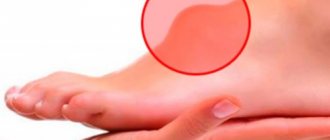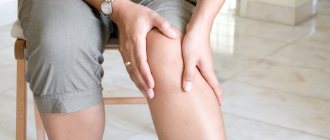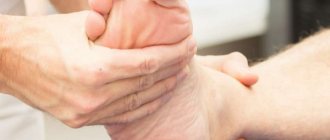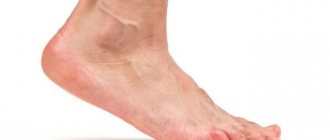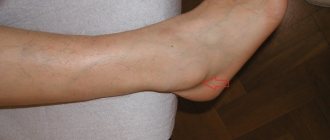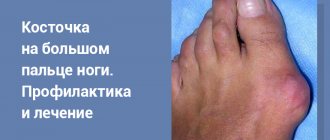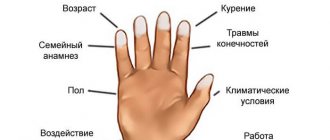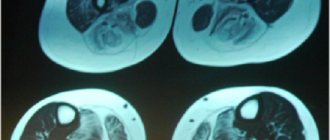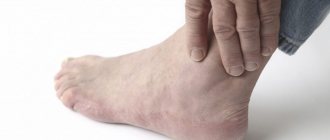Orthopedic doctors very often have to deal with such a problem as hallux valgus. Treatment without surgery of this pathology is possible only in the earliest stages of development. It is quite labor-intensive and time-consuming. But, despite this, most people choose this particular method of treatment, because surgical intervention has its contraindications and can result in long-term rehabilitation and complications. In order to make the right decision in favor of one method or another, it is necessary to understand the causes of the deformity and become familiar with the options for conservative treatment.
Hallux valgus deformity
general information
Hallux valgus is a pathological change in the first metatarsophalangeal joint of the foot. The big toe is displaced from its normal axis in such a way that the head of the first metatarsal bone begins to protrude from the inner surface of the foot. This is the same bone, as people call it. This negatively affects not only the bones, ligaments and muscles of the feet, but in general can bend the spine due to uneven load on the muscles of the legs and back.
In order to increase the chances of recovery without resorting to orthopedic surgery, it is necessary to identify signs of deformity as early as possible. To do this, it is important to know the main manifestations of the disease:
- discomfort and pain while walking;
- slight inclination of the first finger in relation to neighboring fingers;
- gradual formation of the bone;
- hyperemia and increased swelling of the medial surface of the foot;
- the appearance of painful calluses and corns;
- change in foot configuration due to redistribution of body weight to other parts of the foot.
Four degrees of deformation
Physiotherapy
In some cases, physiotherapeutic treatment gives good results. It is prescribed according to the doctor's indications. This treatment is divided into the following types:
- Ultrasonic. Ultrasound heats up problem areas, which accelerates regeneration and metabolism in tissues; during the procedure, the patient receives a kind of micromassage.
- Laser therapy. Due to laser heating, biochemical processes in cells are accelerated, and pain, inflammation and swelling go away.
- Shock wave therapy. Shock waves actively affect muscles, ligaments and cartilage, thereby improving blood flow and metabolism in tissues.
- Mud therapy. Special thermal bags with healing mud are applied to the cones. During the procedure, the tissues receive the necessary substances that help activate important processes.
Physiotherapy can not only cope with inflammation, but also reduce the size of the bunion. It is important to start timely treatment. In this case, it is highly likely that surgical intervention will be avoided.
Do not forget that any treatment should be started only after consultation with a doctor.
The use of certain physical procedures may be contraindicated in the following cases:
- pregnancy;
- infectious diseases;
- problems with blood clotting;
- neoplasms in the area of influence;
- diabetes;
- vascular and heart diseases;
- thrombophlebitis.
Read also: Will orthopedic insoles help with hallux valgus?
That is why, after the initial visit, the doctor prescribes a series of tests, and based on them, selects the most appropriate and effective treatment.
Why does a bunion appear on the finger?
There are many factors that can provoke deformation of the metatarsophalangeal joint of the foot. In order to prescribe the correct treatment regimen, it is necessary to accurately determine the cause of the disease. The most common ones are:
- flattening of the transverse arch of the foot;
- clubfoot;
- narrow shoes with thin heels;
- excess body weight;
- hereditary predisposition;
- foot injuries;
- systemic connective tissue diseases;
- metabolic diseases, such as gout.
It is quite natural that women are more susceptible to this deformation. In the eternal pursuit of model ideals, they subject their feet to long walks in tight shoes with thin, unstable heels. In such a situation, the body weight shifts from the heel to the front of the feet. The tissues seem to be flattened under the influence of the increased load, but the narrow toe of the shoes does not allow this to happen; the emphasis is on the place where the resistance is minimal - the metatarsophalangeal joint. He gradually begins to deviate. Regular wearing of such shoes leads to valgus deformity, as the ligaments and capsule of the joint are stretched, it becomes unstable, and the metatarsal bone rotates in relation to the first toe. If emergency measures are not taken at this stage to eliminate the pathology, inflammation of the joint occurs, that is, bursitis and arthritis, the head of the metatarsal bone thickens and may collapse.
Foot position in heeled shoes
Interesting! Conservative treatment is used in all cases where the risk of complications after surgery exceeds its therapeutic effects. This is especially true for older people with multiple concomitant diseases of other organs and systems.
Main features
The appearance of the claw-shaped finger resembles a bird's claw or a hook. With a “mallet” type curvature, the finger is straight, but the last (distal) phalanx rests perpendicular to the floor.
With a hammertoe deformity, the middle interphalangeal joint “looks” upward, and a gradually hardening callus appears on it. The distal phalanx (with the nail) is located parallel to the floor surface or slightly raised above it. With a combined form on one foot, there are several types of joint deformities.
The initial manifestations of the pathology occur when walking in hard shoes. A person feels discomfort, turning into a dull pain in the fingers. When examining the leg, local swelling and redness of the skin are visible.
The second sign of pathology is the appearance of abrasions, corns, calluses, and rough skin in the front of the foot. Gradually, bones form in the area of the interphalangeal joints of the second and third fingers, and on the side of the metatarsophalangeal joints of the first finger or little finger. A person quickly gets tired when walking, and pain in the foot bothers him more often.
As the disease progresses, movement in the finger joints is limited. They noticeably (by 50% or more) deviate from the physiological position, sometimes “climbing” onto each other. Gradually, the pain when walking becomes more intense and persists at rest, even if there are no shoes on the foot. In advanced cases, when pronounced bumps and calluses form on the second and other fingers, the patient is forced to walk in orthopedic shoes.
Diagnostic measures
After taking a medical history, the doctor examines the foot and then sends the person for an x-ray. The picture is taken in 3 projections. For accurate diagnosis, bacteriological, clinical and biochemical studies of blood, synovial fluid, and urine are carried out. Often the patient is prescribed an ultrasound, computer or magnetic resonance imaging of the foot.
Diagnostics
To make it easier for the doctor to decide on treatment tactics, he carries out a set of diagnostic measures. First, the specialist examines the patient’s feet and evaluates in detail the location of the toe deformity. To obtain more detailed information about the condition of the joint and bones, orthopedists prescribe x-rays of the feet or magnetic resonance or computed tomography. In the diagnostic arsenal of doctors, there is a unique method of plantography, which allows you to determine the distribution of load on certain areas of the foot.
Diagnostics using computer plantography
After an in-depth study of the results of additional research methods, the doctor selects the most effective treatment method. In the initial stages of hallux valgus, when the angle of deviation of the big toe is small and concomitant foot deformities have not yet developed, conservative therapy is indicated.
Prevention
As you know, it is easier to prevent a disease than to treat it. In order to prevent the appearance of a lump in the big toe area, you need to give preference to comfortable shoes with a wide toe box and low heels. People also need to monitor their weight; extra pounds greatly increase the load on the feet, causing the formation of bunions.
People with flat feet are at risk for developing hallux valgus. They should use orthopedic insoles, which can reduce the load on the joint and prevent inflammation.
In addition, the feet need to be constantly strengthened. For this, regular physical activity is indicated. It should be daily and not accompanied by painful sensations. Specially selected exercises will gradually give good results.
Treatment of hallux valgus is a rather difficult process. In advanced cases, it is necessary to resort to surgery. It is quite possible to prevent such a serious situation. To do this, you need to consult a doctor at the first appearance of lumps in the thumb area. It is the specialist who will help you choose the right treatment tactics, and the patient will be able to restore their feet to an attractive appearance only thanks to conservative methods.
Treatment methods without surgery
Treatment of deformity without surgery should solve the following problems:
- Elimination of the causes that lead to curvature of the toe bones.
- Elimination of symptoms of the disease - pain, redness and swelling.
- Correction of metatarsal deformity.
Modern medicine can offer several effective methods for correcting hallux valgus. Often, several treatment methods are used simultaneously to obtain a quick and lasting therapeutic effect. Orthopedists prescribe to their patients:
- anti-inflammatory drugs;
- courses of physiotherapy, massage and other therapeutic measures;
- use of fixing devices;
- use of traditional medicine recipes.
Medications are designed to stop the inflammatory process in tissues. For quick pain relief, take tablets (Ibuprofen, Paracetamol) orally. At home, you can also use ointments and gels for external use, which may have the same name as the tablet form. In combination with tablets, they give more pronounced and faster results.
The method of intra-articular injections is quite widespread. For this purpose, steroid hormone preparations are used, for example Diprospan, Hydrocortisone. The simultaneous use of several dosage forms has a powerful anti-inflammatory effect.
Special treatment measures, which include:
- a course of physiotherapeutic procedures;
- physical therapy classes;
- foot massage;
- special therapeutic diet.
Physiotherapeutic methods increase blood circulation in the tissues around the affected joint and improve their trophism. Thanks to this, regeneration processes occur more intensively, swelling and pain in the foot decreases. Shock wave, laser therapy, diathermy, treatment with ozokerite applications and electrophoresis with medicinal substances are prescribed.
Regular exercise is equally important. Therapeutic gymnastics strengthens weakened muscles, helps develop joints, and restore proper load on the feet, thereby returning them to their normal structure. Typically, training includes general exercises, but more attention is paid directly to the feet. Walking barefoot, smoothly transferring the weight of the body from heels to toes and back, alternating walking on the inner and outer surfaces of the feet, flexion, extension and circular movements of the big toes are very useful.
Gymnastics in combination with therapeutic massage gives very good results. In the hands of an experienced massage therapist, blood circulation increases, joint mobility and ligament elasticity are restored.
Foot massage
An important component in treating hallux valgus is a healthy diet. Fatty, fried and smoked foods should be excluded from your daily diet. It is also recommended to sharply reduce the consumption of confectionery and baked goods. You need to eat foods that are rich in vitamins, especially A, E and C. It is healthy to eat vegetables, fruits and grains. A healthy diet will help restore normal metabolism, reduce body weight and reduce stress on the joints of the legs.
Interesting to know! A proper diet heals the body, improves immune resistance and increases the ability of tissues to self-regenerate.
Conservative treatment of deformity necessarily includes the use of special orthopedic devices. At the moment, their range is quite large and includes:
- insoles;
- screeds;
- orthopedic splints;
- night concealer;
- silicone partitions.
Silicone joint orthosis
Therapeutic shoe insoles are made individually for each patient. Their purpose is to remove the load from the diseased joint and redistribute body weight to the heel. Thus, the foot fully performs its shock-absorbing functions. To correct the phalanx, special splints, silicone partitions and night bandages are used. They firmly hold the big toe in an anatomically correct position. These splints can be worn constantly. Over time, they straighten out the first toe.
Use of a splint for valgus
You cannot ignore traditional medicine recipes that help get rid of illness in combination with traditional methods. Their action is based on the effect of tissue heating. Thus, swelling and pain are reduced and the functioning of the joint is improved. The following recipes are used most often:
- Heat table salt in a frying pan for 8-10 minutes, pour it into a fabric bag or an ordinary sock. Apply salt to the affected joint for about 15 minutes. This procedure can be done 2 times a day during the main treatment.
- A compress of Kalanchoe leaves is made as follows: pre-cooled leaves are doused with boiling water and then beaten to release the juice from the plant. The resulting slurry should be applied to gauze, placed on your finger, and covered with polyethylene and a warm cloth on top. After two hours, the compress should be removed. It is recommended to carry out a course of 7-10 procedures.
- Pine baths also help stop inflammation in the joint. To prepare, you need to make pine concentrate. Take 300 grams of cones, small twigs and needles, fill it with five liters of water and place it on the stove. Next you need to bring to a boil and reduce the heat. Simmer for another half hour and leave in a cool, dry place for 24 hours. Dilute 100 grams of concentrate in a bowl of warm water. It is necessary to take a foot bath for 15-20 minutes.
Important! For successful conservative treatment of deformity, it is very important to constantly wear natural, comfortable shoes with sufficiently dense soles. The maximum permissible heel height is 5 centimeters. It should be wide enough and stable.
Treatment of hallux valgus
Unfortunately, a huge number of people, despite the abundance of information, are still confused about the cause of the growth of a bone near the first finger. Treatment of foot hallux valgus involves several methods.
A lump is not a growth near the finger that they are trying to reduce. It will not disappear when treated with folk remedies. This is the deviation of one bone in the phalanx joint relative to the other. Only an orthopedist or surgeon can correct and treat hallux valgus deformity.
Surgery to remove a bunion on the leg
Surgery on the bunion of the thumb requires rehabilitation after the procedure. There are several options for operations with removal of bone, phalanx, and metatarsal head. Often it is necessary to form the transverse muscular arch of the foot. So that the effect of surgery is long-lasting. And the lump did not form again.
After the operation, special shoes are worn - Baruk boots .
Special shoes with anterior relief will facilitate rehabilitation after surgery. When walking, there is no support on the toe area in such shoes. Therefore, recovery after surgery occurs quickly.
Ointment for a bunion on the big toe
Lotions, rubs, ointments, herbs, etc. will simply relieve inflammation from the lump and reduce pain. This is often enough for those who suffer from pain. After all, we have to limit movement.
However, the size of the hallux valgus will not decrease from rubbing. Home remedies can relieve joint inflammation and pain. But curvature of the fingers can only be corrected using orthopedic devices.
Therefore, you should start with orthopedic treatment. After all, you can postpone the operation.
Orthopedic inserts between the toes
Feet without the necessary arch supports and insoles are subject to improper loading. But with the help of orthopedic products, you can stop hallux valgus. The lump will shrink and disappear completely over time. Thanks to the clamps, you can achieve the correct position of the big toe.
It is better to use several products so that the treatment is consistent. What is the best device to choose for treating a lump on the big toe in the early stages.
■ Corrective finger bandage
■ Silicone inserts between fingers
■ Protective bursoprotector
■ Bursoprotector with insert
Preventive recommendations
To prevent foot diseases, it is important to follow some rules. At the end of a busy working day, you need to lie down and raise your legs on high pillows or a bolster. After 15-20 minutes, excess blood will leave the vessels of the lower extremities, swelling of the legs and ankles will decrease. Additionally, you can make a cool foot bath.
Whenever possible, you should go barefoot. This habit will strengthen the muscles and ligaments of the legs, which will be an excellent prevention of finger deformities.
We can conclude that there are a lot of treatment options for foot valgus, but their effectiveness directly depends on the degree of advanced disease. Therefore, the key to successfully getting rid of the problem is a timely visit to an orthopedist and strict adherence to his recommendations.
Similar:
- Description of the treatment process for a dislocated thumb
- List of toe injuries, ICD codes, causes of injury and treatment rules
- Indications for treatment of hallux valgus with laser
- Treatment of hallux valgus in adults: conservative and surgical methods
- What do parents need to know about hallux valgus in children?
- Causes of hammertoe deformity, treatment of the second toe, diagnostic methods, prevention, symptoms and potential complications
- Why treatment of arthrosis of the thumb should be started immediately
Surgery
In most cases, surgical intervention is resorted to already in advanced stages of the disease. Although surgery can be done at the onset of hallux valgus, in this case surgery will simultaneously prevent arthrosis in the first metatarsophalangeal joint. Modern surgical techniques do not destroy the joint and preserve its support and mobility.
There are such methods of surgical intervention:
- carrying out reconstruction of deformed bones;
- surgical removal of growth;
- an operation that balances the periarticular muscles;
- performing distal and proximal osteotomy, which involves changing the angle between the bones;
- arthrodesis – surgical intervention to fix a joint;
- tendon transfer;
- joint implantation;
- as well as approximately 93 more techniques that are selected individually for each patient.
The rehabilitation process after surgery can last from one to two months, so for 1.5 months, doctors advise wearing a special orthopedic boot, which will help securely fix the affected limb and provide it with maximum peace during movement. [adsense3]
Are there complications?
Valgus deformity of the lower extremities in children provokes a sufficient number of consequences. Arthrosis, which is a destructive-dystrophic disease of the joints, is often diagnosed. In addition, a large number of patients suffering from lower leg deformities are diagnosed with osteochondrosis and curvature of the spinal column. Flat feet, valgus alignment of the feet, and abnormal shape of the hip bone tissue often appear. In addition, due to deformation of the lower leg, shortening of the lower extremities can also be observed.
Symptoms of the disease
Valgus shins in children are not only a cosmetic defect, but significantly reduce the quality of life. As the disease progresses, a person finds it difficult to move, his gait becomes awkward, and the condition is accompanied by the following symptoms:
- Constant aching sensations in the limbs;
- Impaired blood circulation - bluish skin, the appearance of varicose veins;
- Fatigue while moving;
- Swelling in the calf muscles;
- Shuffling of feet while walking.
Symptoms of hallux valgus
Due to improper loading, joints in children are gradually destroyed. If therapeutic measures to eliminate the disease are not taken in a timely manner, the patient will lose the ability to move.
On a note!
In the photo, valgus deformity of the legs looks like an X-shaped curvature, when it is impossible to bring the knees together. There is an obvious displacement of the axes of the limbs, and the distance between the inner ankles becomes more than 5 cm.
